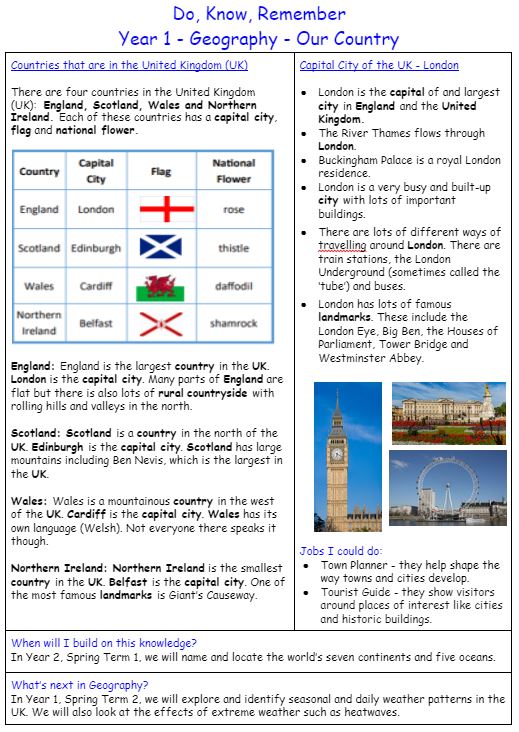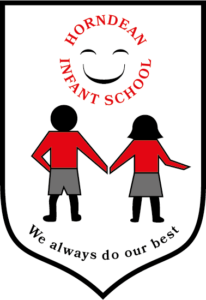Geography
Our Intent, Implementation and Impact statement for Geography
Intent
At Horndean Infant School, our intent is to deliver a high quality geography
curriculum which aims to fulfil the requirements of both the Early Years Foundation Stage and the National Curriculum for geography at KS1; providing a broad, balanced, ambitious and inclusive curriculum whilst also ensuring the progressive development of geographical concepts, knowledge and skills. We aim to inspire a curiosity and fascination about the world and its people that will remain with our children for the rest of their lives. Our curriculum will equip children with a knowledge of diverse places and people, together with a deep understanding of our planet’s key physical and human processes. We want our curriculum to empower children with a deep understanding of local, national and global ecological issues and provide them with the necessary knowledge to make positive change.
Implementation
We have a curriculum that is coherently planned to fulfil the requirements set out in both the Early Years Foundation Stage and the National Curriculum. We have developed a geography schema that organises geographical knowledge in a meaningful way; allowing the children a deep understanding in the way they are connected.
Knowledge is at the heart of our curriculum. Learning knowledge is not an endpoint in itself, it is a springboard to learning more knowledge. Each topic in our overview is underpinned by rich, substantive knowledge and ambitious vocabulary, whilst also ensuring children are developing their disciplinary knowledge (geographical skills). Each unit of work is planned carefully to ensure concepts are taught in optimal order to support children’s understanding. As well as developing a breadth of geographical knowledge, we want our children to become skillful geographers. In addition to substantive and disciplinary knowledge, children will develop their experiential knowledge through carefully planned fieldwork. Some units are essentially human geography; others physical geography, but most are holistic geography, considering human and physical geography together. Place studies start local and increase in scale to regional, national and global, allowing for revisiting, developing and challenging ideas and concepts. Similarly, consideration of the weather and seasons progresses to a more in-depth study of the importance of climate and finally addresses protecting environments from global warming and combating climate change.
The intended Geography curriculum is implemented through the planning,
teaching and assessment of the subject as a specific discipline in each year
group. The teaching of Geography has been designed to make purposeful links
between subjects where possible, with opportunities for learning outside the
classroom embedded in practice. The Geography long term plan sets out the
intended sequencing of the curriculum and the progression document exemplifies what knowledge and skills children will learn as they progress through the school.
All learning will start by revisiting prior knowledge. This will be scaffolded to
support children to recall previous learning and make connections. This allows
teachers to address misconceptions and highlight key areas which need more
revision. Teachers will model explicitly the subject-specific vocabulary,
knowledge and skills relevant to the learning to allow them to integrate new
knowledge into larger concepts. Learning will be supported through the use of
knowledge organisers (DKRs) that provide children with scaffolding that supports them to retain new facts and vocabulary in their long term memory. Knowledge organisers are used for pre-teaching. The Chris Quigley ‘Essentials’ Curriculum is used as a framework for the teaching and learning of Geography in Key Stage One. Some units have also had inspiration from the ‘Twinkl Planit’ Scheme but have been adapted to suit our school locality.
As a school we map:
Breadth of Study – the topics that our children will study.
Threshold Concepts – underpin the main geographical ideas that children
will explore through each topic: investigate places, investigate patterns
and communicate geographically. Our children should be able to
organise their knowledge, skills and understanding around the following
three ‘threshold concepts’ (these are the big ideas that underpin the
subject).
Milestones – The Essentials Curriculum is broken down into three milestones. These are the goals that children should reach to ensure that they are meeting the expectations of the curriculum. In each milestone, children may demonstrate three levels of understanding of the content: Basic, Advancing and Deep learning. In the Early Years, teachers address the threshold concepts throughout the ‘Understanding the World’ area of the curriculum to provide exposure to skills developed throughout Key Stage Working Geographically – Children will use a range of disciplinary thinking skills to support them in working geographically. By the end of their journey at Horndean Infant School, children will be able to: identify, describe, recognise, explore, observe select, classify, sequence and categorise:
Curriculum Enrichment – Where possible, Geography units of work are enriched by a school trip, or by a visitor coming into school. Trips and visitors are carefully planned to ensure they link with what is happening in the classroom. For example, in Nursery, children visit their local
shop to buy foods and learn about job roles in their local community. They also take part in a workshop focusing on the ocean. In Year F, children visit and design their own park and visit Longdown Dairy Farm as part of their learning about farming and where food comes from. In Year 1, children go for a walk to observe key features in the local area and to Southsea Beach to explore human and physical features. They also have a visiting member of staff talk to them about how the school has changed over time. Finally, in Year 2, children have the opportunity to meet a diver and visit the Blue Reef Aquarium when learning about the world’s oceans. They also go on a trip to the Spinnaker Tower where they can observe the human and physical features of Portsmouth from above. Finally, Year 2 take part in a ‘Hot and Cold’ places workshop when learning about climate. Themed days including World Ocean Day and Earth Day allow children to further explore global issues. Continuous provision in each classroom allows children to apply their geographical knowledge and understanding through their play based experiences. Cultural suitcases in each class support children to develop an understanding of their class country and the cultures and celebrations of friends and teachers in their class. Children also experience ‘food themed lunches’ where they can experience tasting foods from each class country in the school.
Weekly assemblies dedicated to highlighting topics from ‘Picture News’ allows
children to have an understanding of current events or issues that are happening around the world. Linked with the school’s PSHE curriculum, it supports children to understand their place in their world and encourages them to think, question and develop an opinion on current issues such as those relating to climate change.
Impact
Assessment & Monitoring – Through the explicit teaching of geographical knowledge and skills, both teachers and children assess their learning throughout lessons. Gaining evidence of children’s understanding is a formative and ongoing process. Teachers can use ‘I can’ statements to support their assessment of children’s understanding of the key objectives within each lesson. This can then be used to inform teachers with planning lesson activities and differentiation, as well as to address misconceptions that may arise. Summative assessment is completed at the end of each topic in the form of ‘Now I Know’ quizzes where geography objectives have been covered. At the end of the year, teachers complete a summative assessment using evidence gathered throughout the year to assess children against the cognitive domains within milestone one. Floor books evidence a broad and balanced geography curriculum and demonstrate the children’s acquisition of identified key knowledge. Children’s work demonstrates that geography is taught at an age appropriate standard across each year group and that children working at all levels are considered and planned for effectively. This includes recording work in a variety of ways and ensuring that disadvantaged children and those with SEN are given full access to the Geography
curriculum. Opportunities include:
ORAL – paired discussion, presentations, debating, role play, questioning, etc.
WRITTEN – weather diaries, leaflets, posters, postcards and a range of extended writing – descriptive, comparative, explanatory etc.
GRAPHIC – digital picture collections, tables, graphs, paintings, photographs and labelled sketches and maps etc.
CONSTRUCTIONS – models, small world layouts, and collections etc.
In the Early Years, evidence is recorded as observations on Tapestry. This allows for judgements to be made regarding whether a child has achieved the Early Learning Goal at the end of Year F, in this case Understanding the World.
The summative assessments inform teachers and the geography leader of the
knowledge or skills that need to be further enhanced and progress can be
tracked throughout school. The Geography Subject Lead is then able to use the
evidence collected alongside the assessment information to monitor and track
the implementation of the subject’s curriculum to ensure that our intentions are achieved. The impact of the Geography curriculum is evaluated through regular monitoring. The purpose of this is to highlight the impact of the implemented curriculum, its strengths and areas for review.
Pupil Voice – We believe that if children have become knowledgeable and skilful geographers, then they will be able to articulate their understanding with confidence. This is why pupil voice is an important tool in assessing whether children have made progress. The Geography lead also holds pupil conferences where they meet with pupils regularly to discuss their Geography learning. Pupil voice is additionally added to each lesson montage within our humanities floor books. Our geography curriculum is also celebrated through displays in classrooms and throughout the school.


